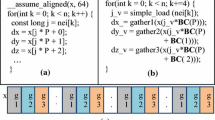Abstract
In this work we studied the influence of the vector register size over two different concepts of vector architectures. Long vector registers play an important role in a conventional vector architecture, however, even using highly vectorisable codes, only a small fraction of that large vector registers is used. Reducing vector register size on a conventional vector architecture results in a severe performance degradation, providing slowdowns in the range of 1.8 to 3.8. When we included an out-of-order execution on a vector architecture, the need for long vector registers was reduced. We used a trace driven approach to simulate a selection of the Perfect Club and Specfp92 programs. The results of the simulations showed that the reduction of the register size on an out-of-order vector architecture led to slowdowns in the range of 1.04 to 1.9. These compare favourably with the values found for a conventional vector machine. Even when reducing the registers size to 1/4 of the original size on an out-of-order machine, the slowdown was between 1.04 and 1.5, and was better still than on a conventional vector machine. Finally, when comparing both architectures, using the same register file size (8kb) we found that the gains in performance using out-of-order execution were between 1.13 and 1.40.
Access this chapter
Tax calculation will be finalised at checkout
Purchases are for personal use only
Preview
Unable to display preview. Download preview PDF.
Similar content being viewed by others
References
Villa, L., Espasa, R., Valero, M.: Effective usage of vector registers in advanced vector architectures. In: Malyshkin, V.E. (ed.) PaCT 1997. LNCS, vol. 1277. Springer, Heidelberg (1997)
Espasa, R., Valero, M., Smith, J.E.: Out-of-order Vector Architectures. In: MICRO-30, pp. 160–170. IEEE Press, Los Alamitos (1997)
Lee, C.G., Smith, J.E.: A study of partitioned vector register files. Supercomputing, 94–103 (1992)
Diede, T., Hagenmaier, C.F., Miranker, G.S., Rubinstein, J.J., Worley Jr., W.S.: The Titan graphics supercomputer architecture. IEEE Computer 21(9), 13–30 (1988)
Utsumi, T., Ikeda, M., Takamura, M.: Architecture of the VPP500 Parallel Supercomputer. In: Proceedings of Supercomputing 1994, Washington D.C. IEEE Computer Society Press, Los Alamitos (1997)
Espasa, R., Valero, M.: Decoupled vector architectures. In: HPCA-2, pp. 281–290. Computer Society Press (February1996)
Espasa, R., Valero, M.: Multithread vector architectures. In: HPCA-3, February 1997, pp. 237–249. Computer Society Press (Februrary 1997)
Villa, L., Espasa, R., Valero, M.: Effective usage of vector registers in advanced vector architectures. In: Parallel and Distributed Computing (PDP 1998), Madrid, Spain (1998)
Convex Press, Richardson, Texas, USA. CONVEX Architecture Reference Manual (C series), 6 ed. (April 1992)
Yager, K.C.: The Mips R1000 Superscalar Microprocessor. IEEE Micro, 28–40 (April 1996)
Espasa, R., Martorell, X.: Dixie: a trace generation system for the C3480. Technical report: CEPBA-RR-94-08, Universitat Politècnica de Catalunya (1994)
Espasa, R.: JINKS: A parametrizable simulator for vector architectures. Technical report: UPC-CEPBA-1995-31, Universitat Politècnica de Catalunya (1995)
Author information
Authors and Affiliations
Editor information
Editors and Affiliations
Rights and permissions
Copyright information
© 1999 Springer-Verlag Berlin Heidelberg
About this paper
Cite this paper
Villa, L., Espasa, R., Valero, M. (1999). Registers Size Influence on Vector Architectures. In: Hernández, V., Palma, J.M.L.M., Dongarra, J.J. (eds) Vector and Parallel Processing – VECPAR’98. VECPAR 1998. Lecture Notes in Computer Science, vol 1573. Springer, Berlin, Heidelberg. https://doi.org/10.1007/10703040_33
Download citation
DOI: https://doi.org/10.1007/10703040_33
Publisher Name: Springer, Berlin, Heidelberg
Print ISBN: 978-3-540-66228-0
Online ISBN: 978-3-540-48516-2
eBook Packages: Springer Book Archive




